How to Do the Incline Dumbbell Bench Press for Upper Pec Muscle and Pressing Strength
Developing a strong pressing movement is pretty standard advice for any lifter looking to make big gains in upper body development. The incline dumbbell bench press, in particular, will add some spice to your chest workout by using a new angle of attack to bring some unique perks.Credit: MDV Edwards / Shutterstock Between the dumbbells, inclined body position, and some clever programming choices, you’ll set the stage for some long-term progress in size and strength. Here’s why this chest exercise should be a staple for sculpting your upper body. Incline Dumbbell Bench Press How to Do the Incline Dumbbell Bench Press Step by Step The incline dumbbell bench press adds a few new elements to your normal pressing performance. Considering all the moving parts to this variation will help you stay dialed in and make great progress session-to-session. Ideally, the incline dumbbell press requires an adjustable bench to choose your incline setting and a pair (or full set) of dumbbells. Step 1 – Get on the Right Bench Credit: MDV Edwards / Shutterstock Set the backrest to an angle of roughly 45 degrees (or the closest angle available) and adjust the seat to be perpendicular to the rest of the bench — you won’t be as secure with an incline backrest and horizontal seat. This setup will allow you to press from a nice, effective middle ground between flat dumbbell bench press and a fully upright shoulder press, and the seat angle will more effectively support your body. Form Tip: Make sure your bench settings are locked in before you start. Test the angle with lighter dumbbells, or without weight, to make sure everything is in comfortable and efficient alignment prior to going heavy. Step 2 – Bring the Weights Into Position Credit: MDV Edwards / Shutterstock Pick up the dumbbells and take a seat on the incline bench. Rest the dumbbells on your thighs with your thumbs pointed up. “Kick” the dumbbells up toward your shoulders using your legs to generate momentum as you control the weight in a hammer curl motion, bringing your thumbs near the fronts of your shoulders. When your wrists are near shoulder-level, carefully rotate your elbows away from your body until your palms are facing forward. Rest your shoulder blades against the backrest to fully support your upper body. Form Tip: You might be able to bring both dumbbells up simultaneously when using relatively lighter weights, but it can become higher risk once weights get heavy. Focus on getting one dumbbell into position first, then hold it stable as you repeat with the other side. If you’re struggling with getting the dumbbells up into the starting position, ask a friend (or friendly looking gym-goer) for a spot. Step 3 – Set Your Shoulder Blades, Core, and Feet Credit: Vladimir Sukhachev / Shutterstock Tuck your shoulder blades down and imagine putting them “into your back pockets.” This will help stabilize your upper back and make sure your pressing has a strong base to produce force, particularly once fatigue starts to accumulate. Squeeze the dumbbells tightly in your hands and engage your abdominal muscles. The goal here is to prevent any unintentional arching — some natural back curvature will be normal from pinning your shoulder blades, but you’ll want to avoid any extreme arching which could lead to lower back pain. This way, your incline press will remain an incline and not slowly turn into an awkward “flat bench press using an incline.” Find a comfortable foot position approximately shoulder-width apart. Once the rest of your body is set up properly, begin lightly driving through your feet to establish pressure that pushes your body into the bench. This will help stabilize your position all the way through the set and allow you to prevent wiggling around during harder reps. Form Tip: Think about pinning your upper abdominal muscles to the top of your ribcage. This visualization should help you create a strong core. To keep your feet in place, think of performing a leg extension to create tension while your feet are digging into the ground. Step 4 – Press to Lockout Credit: Slatan / Shutterstock The main event has arrived. Begin with the dumbbells just above shoulder-height, both palms facing forward, and your elbows aimed at a slight angle between your shoulders and your feet. Tense your shoulder blades, engage your core, drive through your feet as you press the weights toward the ceiling. As the dumbbells pass your face, bring them slightly together in an arc until they nearly meet. In the locked out position, the weights should be generally above your face, not too far forward (above your chest) or too far back (above the top of your head). Form Tip: If you can focus on mastering the right setup while applying full-body tension, the dumbbells’ path should almost set itself up perfectly. If you’re struggling with controlling the weights, try adding tempo by moving more slowly through each phase of the exercise. Step 5 – Lower the Wei
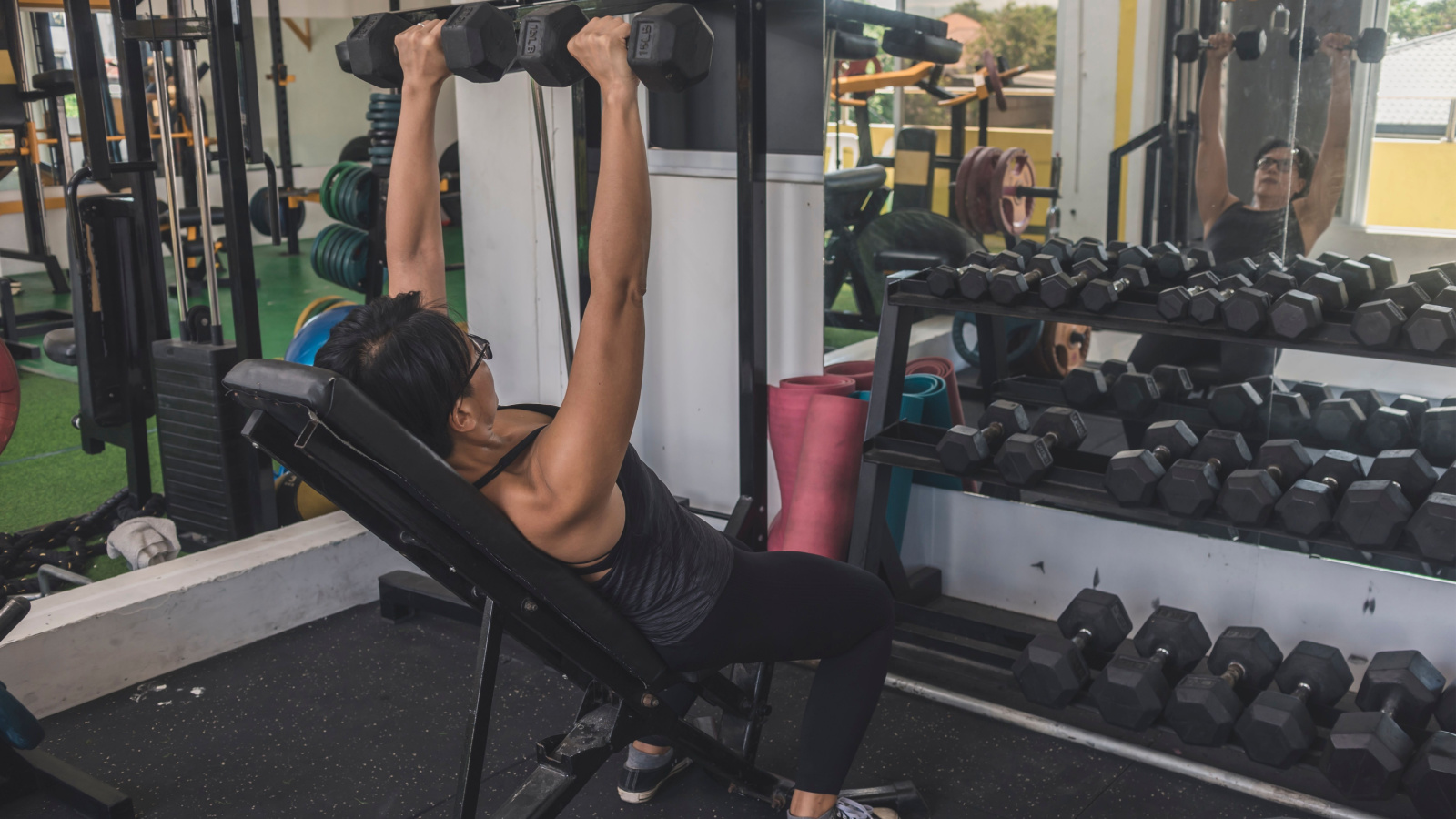
Developing a strong pressing movement is pretty standard advice for any lifter looking to make big gains in upper body development. The incline dumbbell bench press, in particular, will add some spice to your chest workout by using a new angle of attack to bring some unique perks.

Between the dumbbells, inclined body position, and some clever programming choices, you’ll set the stage for some long-term progress in size and strength. Here’s why this chest exercise should be a staple for sculpting your upper body.
Incline Dumbbell Bench Press
How to Do the Incline Dumbbell Bench Press Step by Step
The incline dumbbell bench press adds a few new elements to your normal pressing performance. Considering all the moving parts to this variation will help you stay dialed in and make great progress session-to-session. Ideally, the incline dumbbell press requires an adjustable bench to choose your incline setting and a pair (or full set) of dumbbells.
Step 1 – Get on the Right Bench

Set the backrest to an angle of roughly 45 degrees (or the closest angle available) and adjust the seat to be perpendicular to the rest of the bench — you won’t be as secure with an incline backrest and horizontal seat. This setup will allow you to press from a nice, effective middle ground between flat dumbbell bench press and a fully upright shoulder press, and the seat angle will more effectively support your body.
Form Tip: Make sure your bench settings are locked in before you start. Test the angle with lighter dumbbells, or without weight, to make sure everything is in comfortable and efficient alignment prior to going heavy.
Step 2 – Bring the Weights Into Position

Pick up the dumbbells and take a seat on the incline bench. Rest the dumbbells on your thighs with your thumbs pointed up. “Kick” the dumbbells up toward your shoulders using your legs to generate momentum as you control the weight in a hammer curl motion, bringing your thumbs near the fronts of your shoulders.
When your wrists are near shoulder-level, carefully rotate your elbows away from your body until your palms are facing forward. Rest your shoulder blades against the backrest to fully support your upper body.
Form Tip: You might be able to bring both dumbbells up simultaneously when using relatively lighter weights, but it can become higher risk once weights get heavy. Focus on getting one dumbbell into position first, then hold it stable as you repeat with the other side. If you’re struggling with getting the dumbbells up into the starting position, ask a friend (or friendly looking gym-goer) for a spot.
Step 3 – Set Your Shoulder Blades, Core, and Feet
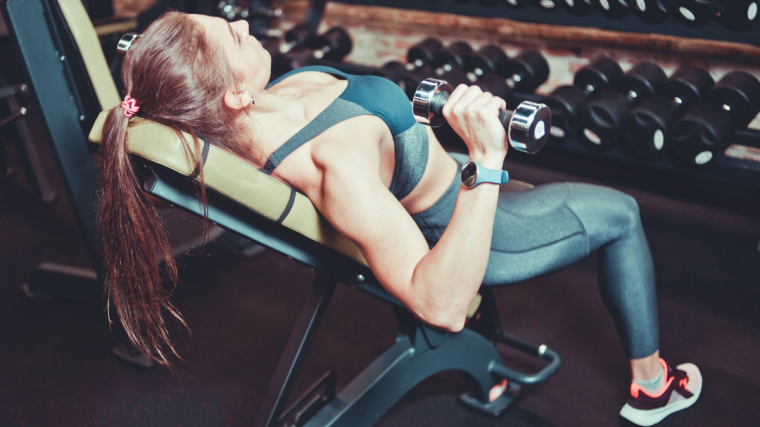
Tuck your shoulder blades down and imagine putting them “into your back pockets.” This will help stabilize your upper back and make sure your pressing has a strong base to produce force, particularly once fatigue starts to accumulate.
Squeeze the dumbbells tightly in your hands and engage your abdominal muscles. The goal here is to prevent any unintentional arching — some natural back curvature will be normal from pinning your shoulder blades, but you’ll want to avoid any extreme arching which could lead to lower back pain. This way, your incline press will remain an incline and not slowly turn into an awkward “flat bench press using an incline.”
Find a comfortable foot position approximately shoulder-width apart. Once the rest of your body is set up properly, begin lightly driving through your feet to establish pressure that pushes your body into the bench. This will help stabilize your position all the way through the set and allow you to prevent wiggling around during harder reps.
Form Tip: Think about pinning your upper abdominal muscles to the top of your ribcage. This visualization should help you create a strong core. To keep your feet in place, think of performing a leg extension to create tension while your feet are digging into the ground.
Step 4 – Press to Lockout
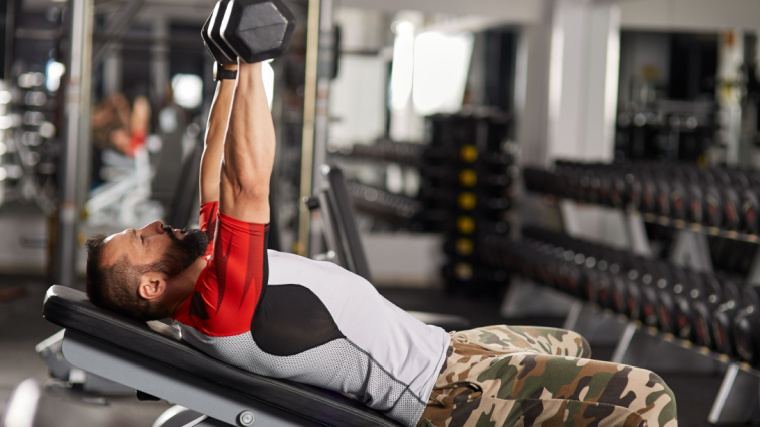
The main event has arrived. Begin with the dumbbells just above shoulder-height, both palms facing forward, and your elbows aimed at a slight angle between your shoulders and your feet. Tense your shoulder blades, engage your core, drive through your feet as you press the weights toward the ceiling.
As the dumbbells pass your face, bring them slightly together in an arc until they nearly meet. In the locked out position, the weights should be generally above your face, not too far forward (above your chest) or too far back (above the top of your head).
Form Tip: If you can focus on mastering the right setup while applying full-body tension, the dumbbells’ path should almost set itself up perfectly. If you’re struggling with controlling the weights, try adding tempo by moving more slowly through each phase of the exercise.
Step 5 – Lower the Weight

After successfully locking out the weight, slowly lower the dumbbells. Once the dumbbells are approximately flush alongside your chest (if mobility allows that range of motion), reverse course and perform the next repetition, pressing the dumbbells with control back to the lockout position.
Form Tip: Lifters with poor shoulder mobility or pre-existing shoulder issues may not be comfortable with the stretched position created by holding the dumbbells near shoulder-level. Work within a comfortable, pain-free range of motion to avoid worsening any current joint problems. Pressing with a neutral grip (palms facing each other) instead of a palms-forward grip can also help to reduce shoulder-joint strain.
Incline Dumbbell Bench Press Mistakes to Avoid
Some of the most common errors you may stumble across while performing the incline dumbbell press involve various incorrect body positioning and poorly performed pressing. Any one of these can reduce results or create an opportunity for injury. Here’s what to watch out for.
Overarching
Some degree of arching during any type of chest press is a necessary and direct result of setting a stable upper back. However, issues can arise if your arch gets out of control and too extreme.
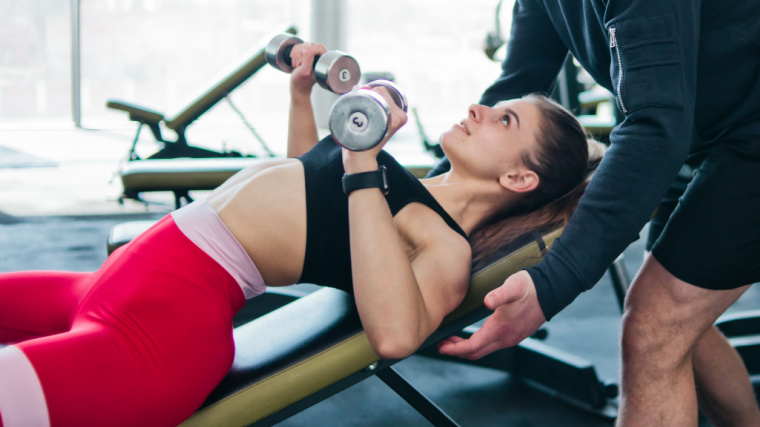
If your abdomen begins to approach the same level as your sternum or chest, you may find yourself with an awkwardly angled torso that begins to more closely resemble a flat press than an incline.
Avoid it: Keep your core braced, drive your body into the bench using your legs, and only arch by depressing your shoulder blades — tucking them into your “back pockets.” Don’t arch by trying to “make space” between your lower back and the bench.
Flared Elbows
There is a sweet spot for your elbow angle during most presses. A common mistake is flaring your elbows out so that your arms are almost completely perpendicular to your body.
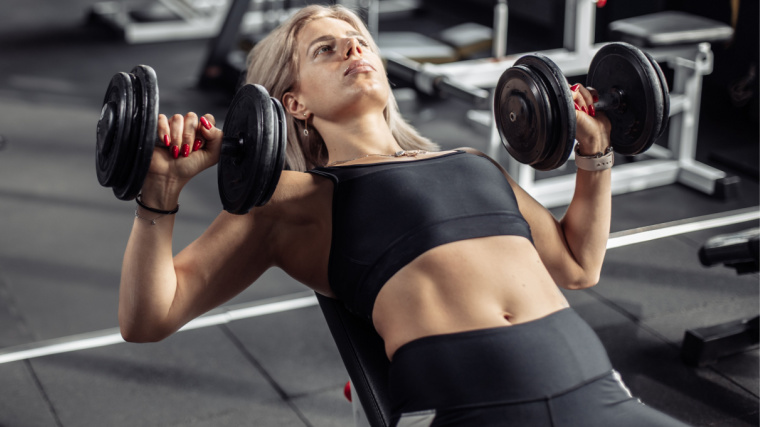
Everybody is going to be slightly different depending on their individual arm length, but there’s a strong chance this directly outward position might limit your range of motion or run into some stressful issues at your shoulder joints or shoulder blades.
Avoid it: Aim for a nice middle ground between having your elbows fully tucked (aimed straight ahead) and fully flared (aimed straight to the sides). A great target to shoot for is to have your upper arms at roughly a 45-degree angle from your shoulder during most of the range of motion.
Inactive Legs
One very common mistake on the incline dumbbell press is completely forgetting about your lower body. While pressing is clearly designed to primarily target your chest, triceps, and shoulders, an active and engaged lower body can help with total-body stability and overall performance.
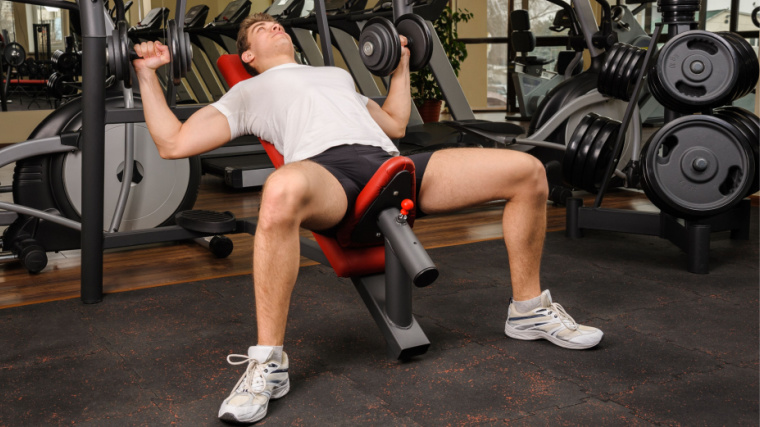
Avoid it: Because wiggling around can reduce your stable position, keep your feet flat on the ground and dig in. Use your legs to constantly push yourself into the bench press pad through your thighs and hips.
Short Range of Motion
Training with high intensity is a pretty common prerequisite for results. Unfortunately, it isn’t uncommon to see a lifter “cut depth” as an exercise starts to get harder and harder.

Either through selecting too heavy of a dumbbell or simply by accumulating fatigue across a set, the range of motion often starts to diminish slowly and the last few reps of a set may end up with a shorter range of motion than the initial reps of the same set.
Avoid it: Hold yourself accountable throughout the workout. Perform a consistent range of motion for each repetition and choose your working weights to guarantee you can hit it with every rep of every set.
How to Progress the Incline Dumbbell Bench Press
The incline dumbbell press can be an excellent staple exercise in your program. There is some big value in getting a strong base of strength using a machine chest press or flat bench variation first, but once you’re at the incline dumbbell press, progressing it can be approached in a few very effective ways.
Degree of Incline
The bench’s degree of incline will affect your level of stability and can potentially even alter the swath of muscle that gets the greatest stimulation (1). These two considerations can help you plan your preferred “angle” of attack. They can also give you a nice long pathway to progress.

Typically, a lower incline (flat or slightly above flat) will be more stable because gravity is still assisting your stability to a greater extent. Each time you feel ready to increase the challenge and progress yourself to another level, kick the incline up a notch until you’re at a solid 45-degree for a pure incline press.
Just know that as the angle goes higher than 45 degrees, and approaches a 90-degree “incline” bench, you’re shifting muscular stress further from your chest and more directly onto your shoulders.
Adding Repetitions
Sometimes the best option is to add repetitions while maintaining the same load on your incline dumbbell press. Since you’re using dumbbells as the loading tool, the unilateral (single-sided) aspect of the exercise can make quick jumps in weight a lot harder to do since each arm is responsible for, literally, carrying its own share of the weight.
If this is the case for you, adding repetitions on one or more sets per workout, or gradually increasing the total repetitions performed per day overall, can be a way of progressing. This will allow you more time to strengthen your ability to control and stabilize the same load, which will make an increase in weight feel less daunting when you finally do move to heavier weights.
Adding Load
Adding load is often the most obvious way of progressing any exercise, although it should be approached with care. Using heavier weights can help assure definitive, measurable progress — but it may also run you headlong into an early plateau.
Once you have added a considerable amount of strength and stability by increasing repetitions, start thinking about making the smallest incremental jump in load that you can which will help to avoid hitting a plateau and allow more long-term progress. Many dumbbells are fixed in five-pound increments, but you might also have access to plate-loaded adjustable dumbbell handles or magnetic add-on weights which can be attached to dumbbells and allow increases as little as one or two pounds.
Increasing Frequency
Sometimes, to see the best overall progress in an exercise, you need to work on your skill and technique. In this case, it can be extremely beneficial to increase your training frequency by performing the incline dumbbell press more often each week.
If you only train the movement once per week, consider adding a second session to improve your skilled execution. This can have a very positive amplifying effect on all of your other progression tools as well.
Benefits of the Incline Dumbbell Bench Press
The incline dumbbell press is a fantastic tool for strengthening your upper body, building more chest muscle, and taking advantage of a unilaterally controlled exercise.
Gaining Strength
Aside from a basic barbell, dumbbells are one of the most effective tools for building strength. The full-body stability, coordination, and absolute load that dumbbells can achieve make for a fantastic strength training option.
The incline dumbbell press is an effective common accessory exercise in many powerlifting programs, speaking to the value of the movement in developing significant pressing strength.
Building Muscle
The incline dumbbell press can be a very effective muscle-building exercise. The incline angle can help you target your upper chest while also building your shoulders and triceps. Because the dumbbells allow you to bring the weights together in the top position, you can get a longer range of motion compared to using a fixed barbell. This may further improve the muscle-building stimulus. (2)
Training Unilaterally
Perhaps one of the biggest benefits is the unilateral aspect of the exercise. Unilateral exercises typically emphasize one side of the body working independently of the other.

Each arm is responsible for controlling one dumbbell without assistance from the opposite side. This will help encourage the most natural pressing path because the load is distinct and not linked like a barbell, allowing your shoulder and elbow joints to move more with relatively more freedom and potentially less joint strain. The increased stability requirement will also force a more even development of strength and coordination.
Muscles Worked by the Incline Dumbbell Bench Press
The incline dumbbell press primarily works three major upper body muscles — your chest, shoulders, and triceps. While these are sometimes considered “vanity” muscles due to their high-profile appearance, they also play a key role in displaying upper body strength and stability.
Chest
The primary body part involved is your chest (or pectoralis major). The chest is a broad swath of muscle that covers many spots all across the front of your upper body — from your collarbones to the breastbone and even some of the ribs.
Each of these regions insert upon the same location at your upper arm meaning, so any pressing angle will ultimately harness the full chest. However, the incline dumbbell press puts a particular emphasis on the upper muscle fibers, or the highly sought after “upper pecs.” (3)
Shoulders
Your shoulders (in particular, the anterior deltoid or front shoulder muscle) are a nearly inseparable part of any pressing exercise. The anterior deltoid originates on the outside of your collarbone and inserts on the deltoid tuberosity (a small protrusion on the outer-middle part of your upper arm bone). Since it’s located here, most of your chest presses and chest flye exercises will similarly draw upon the anterior deltoid muscle.
Triceps
The triceps are a meaty muscle comprised of three separate heads working together, on the back side of your upper arm. They are responsible primarily for extending your elbow, so they will be heavily involved in successfully completing any pressing exercise.
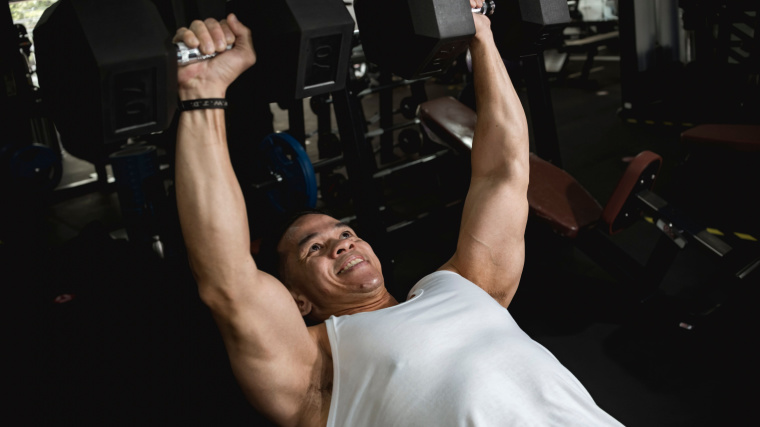
Pressing with your elbows and upper arms set approximately 45-degrees from your shoulder can harness a ton of triceps activation because of the improved depth and increased range of motion you can achieve.
How to Program the Incline Dumbbell Bench Press
The incline dumbbell press can be a surprisingly versatile exercise for your repertoire. It can serve as a primary movement of the day, an accessory performed after a heavier exercise, it can be used as a “pre-fatigue” tool to focus on chest development, and it can even be involved in a movement preparation or warm-up.
Primary Movement
Your primary movement is the meat and potatoes of any workout. It’s the first exercise performed in the session, typically because it’s the movement you’ll approach with the greatest amount of effort and energy.
As a primary exercise, the incline dumbbell press can be used for hypertrophy (muscle-building) or even for building strength once you start to get familiar with the movement. A few sets of 8-12 repetitions will be a great muscle-builder. If you’re able to safely execute in the 6-8 range, it can also be leveraged for strength.
Accessory Exercise
If it’s not the first exercise of your workout, the incline dumbbell press is a strong candidate for the second movement of the day. Once you’ve completed, for example, a heavy flat barbell bench press, it’s common to slide the incline dumbbell bench press into the next slot to train the muscles from a different angle and/or with different loading and volume.
This approach can be an effective way to build muscle, but it can also help shore up shoulder mobility and stability due to the inclined angle and varied range of motion from the previous exercise. Since your muscles will already be a bit tired from the main exercise, you’ll get plenty of stimulation from a slightly lighter load while aiming for 8-12 repetitions per set.
Pre-Fatigue
Pre-fatigue is a strategic technique for your programming. In a perfect world, you’d have all the access to loading and every potential exercise at your whim, but sometimes you’re stuck with a limited amount of training tools available. In these instances, pre-fatiguing your chest with a targeted exercise like the incline dumbbell press can sufficiently work the muscle enough to keep any following exercises challenging enough to deliver significant stimulation.
This is similar to using the exercise as a primary movement, but maintains the intention and effectiveness of additional exercises. Pair the incline dumbbell press with tempo training (lifting and lowering slowly) and moderate repetitions in the 10 to 12 rep range, and it can be a powerful way to breathe new life into any chest-focused workout.
Movement Preparation
Movement preparations are warm-up plans that use exercises themselves in a clever and efficient way to check many boxes simultaneously. The incline dumbbell press can be used as a part of your warm-up routine to make sure you have access to all the range of motion you might need for a barbell variation or flat bench press, for example.
It will also serve to practice your ability to stabilize your upper back and shoulders prior to hitting more heavily loaded exercises in your workout. Think of the incline dumbbell press as the final check before advancing to your primary movement of the day.
Incline Dumbbell Bench Press Variations
If you are looking for some effective chest exercises similar to the incline dumbbell press, changing the implement or slightly modifying the pattern are solid options. The incline machine press, incline cable press, neutral-grip incline dumbbell press, and incline dumbbell power flye can all be great tools at your disposal.
Incline Machine Press
The incline machine press will assume a more fixed range of motion than the incline dumbbell press. Since it is locked in its own path, you are often able to load the exercise heavier because your stabilizing muscles are less of a limiting factor.
The stability of the machine also lets you more safely approach muscular failure and more safely going past failure with intensity techniques like forced reps, compared to dumbbells. These are great benefits if you’re pursuing muscle and strength gains, but some machines can be a bit tricky if they doesn’t perfectly fit your frame.
Incline Cable Press
The incline cable press can be a uniquely effective modification to the dumbbell movement. You will still get unilateral benefits, but you’ll also get a touch more stability when using cables rather than dumbbells.
You can expect a greater range of motion that will easily accommodate individual limb lengths. Cables also offer constant tension by maintaining muscular stress throughout the entire movement, which can help to stimulate more muscle growth. (4)
Neutral-Grip Incline Dumbbell Bench Press
A neutral-grip incline dumbbell press places you in a slightly more stable position than the standard incline dumbbell press grip (with your palms facing forward). If you are working toward more mobile and stable shoulders, improve your odds by selecting an angle of incline that currently works for you (such as a slightly lower angle) and pressing with a neutral grip.
You will still be able to gain some serious baseline strength, coordination, and stability, but the neutral grip will lessen the challenge slightly.
Incline Dumbbell Power Flye
The incline power flye is a great combination exercise. It’ combines’s one-part dumbbell press variation and one-part chest flye variation. The unique exercise involves bending your arms to a more significant degree than during a normal flye pattern.
It still hits your upper chest with an incline movement, but the flye motion allows you to make gains even when you’re limited in load. When you’re in a pinch for equipment or want to blast your chest in minimum time, performing the incline dumbbell power flye with a medium load for moderate reps can be just the fix.
FAQs
This might be a sign that the load is too great or your incline is set too high for your current abilities. Try starting with a much lower incline or slightly reducing the weight.
You can also employ tempo training for a few weeks — taking two or more seconds to lift the weight and another two or more seconds to lower each repetition. The slower tempo can help you focus on control and you should be able to stabilize much more effectively with less movement at your elbows.
You can use both of these exercises within the same training program, but the best recommendation is to split them into separate training sessions to avoid redundancies.
They offer distinct benefits, but they are both dumbbell presses. To keep your options open for more variable training on either day, choose one dumbbell press to do in each upper body training session, and then move on to other exercises that cover different ground.
You can start to strategically manipulate your training variables to break or avoid these plateaus. As you start to notice your results slowing, change your angle of inclination from the lowest to moderate and then the highest — stopping before it becomes a fully vertical shoulder press.
You can also pair this with changing load and repetitions ranges as well, steadily going from lighter weight with higher repetitions to heavier weights with lower repetitions. Together, these two solutions should keep you progressing for a long time.
Press On
The incline dumbbell bench press is an excellent meshing of many different training tools and beneficial concepts: Independently manipulated dumbbells, a long range of motion, stability and mobility demands, and very versatile programming potential. Any one of these benefits is reason enough to start tinkering with this movement, let alone all of them together. If you’re looking to sneak in some new pressing gains and pumped up upper pecs, look no further than this simple, classic, and effective movement.
References
- Chaves, S. F. N., Rocha-JÚnior, V. A., EncarnaÇÃo, I. G. A., Martins-Costa, H. C., Freitas, E. D. S., Coelho, D. B., Franco, F. S. C., Loenneke, J. P., Bottaro, M., & Ferreira-JÚnior, J. B. (2020). Effects of Horizontal and Incline Bench Press on Neuromuscular Adaptations in Untrained Young Men. International journal of exercise science, 13(6), 859–872.
- Schoenfeld, B. J., & Grgic, J. (2020). Effects of range of motion on muscle development during resistance training interventions: A systematic review. SAGE open medicine, 8, 2050312120901559. https://doi.org/10.1177/2050312120901559
- Rodríguez-Ridao, D., Antequera-Vique, J. A., Martín-Fuentes, I., & Muyor, J. M. (2020). Effect of Five Bench Inclinations on the Electromyographic Activity of the Pectoralis Major, Anterior Deltoid, and Triceps Brachii during the Bench Press Exercise. International journal of environmental research and public health, 17(19), 7339. https://doi.org/10.3390/ijerph17197339
- Burd, N. A., Andrews, R. J., West, D. W., Little, J. P., Cochran, A. J., Hector, A. J., Cashaback, J. G., Gibala, M. J., Potvin, J. R., Baker, S. K., & Phillips, S. M. (2012). Muscle time under tension during resistance exercise stimulates differential muscle protein sub-fractional synthetic responses in men. The Journal of physiology, 590(2), 351–362. https://doi.org/10.1113/jphysiol.2011.221200







